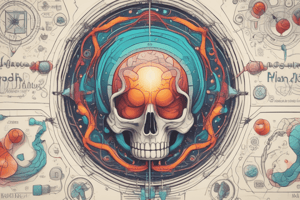Podcast
Questions and Answers
A patient reports experiencing pain. Which neurotransmitter is primarily responsible for transmitting pain signals to the brain?
A patient reports experiencing pain. Which neurotransmitter is primarily responsible for transmitting pain signals to the brain?
- Substance P (correct)
- Dopamine
- Serotonin
- Norepinephrine
The gate control theory of pain suggests that pain transmission can be modulated at what level?
The gate control theory of pain suggests that pain transmission can be modulated at what level?
- Thalamus
- Peripheral nerves
- Spinal cord (correct)
- Cerebral cortex
Which of the following opioid receptors are involved in modulating pain?
Which of the following opioid receptors are involved in modulating pain?
- Alpha and Beta receptors
- Nicotinic and Muscarinic receptors
- CB1 and CB2 receptors
- Mu, Kappa, and Delta receptors (correct)
A patient undergoing methadone treatment is most likely being treated for:
A patient undergoing methadone treatment is most likely being treated for:
Naloxone (Narcan) is an example of which type of drug?
Naloxone (Narcan) is an example of which type of drug?
Which mechanism of action best describes how NSAIDs reduce pain and inflammation?
Which mechanism of action best describes how NSAIDs reduce pain and inflammation?
Acetaminophen reduces pain but not inflammation through which mechanism?
Acetaminophen reduces pain but not inflammation through which mechanism?
A patient's blood pressure reading is consistently above 180/120 mmHg. What condition does this indicate, and what immediate action is required?
A patient's blood pressure reading is consistently above 180/120 mmHg. What condition does this indicate, and what immediate action is required?
The RAAS system regulates blood pressure through the action of which two substances?
The RAAS system regulates blood pressure through the action of which two substances?
Furosemide (Lasix) is what classification of diuretic?
Furosemide (Lasix) is what classification of diuretic?
Which of the following is a potassium-sparing diuretic?
Which of the following is a potassium-sparing diuretic?
Verapamil is a calcium channel blocker that primarily affects the heart and is therefore classified as:
Verapamil is a calcium channel blocker that primarily affects the heart and is therefore classified as:
ACE inhibitors work by:
ACE inhibitors work by:
Nitroglycerin is administered to patients experiencing angina to primarily:
Nitroglycerin is administered to patients experiencing angina to primarily:
What is the primary mechanism of action of beta-blockers in treating angina?
What is the primary mechanism of action of beta-blockers in treating angina?
Warfarin (Coumadin) is classified as what type of medication?
Warfarin (Coumadin) is classified as what type of medication?
Alteplase (tPA) works to:
Alteplase (tPA) works to:
Digoxin, a cardiac glycoside, is prescribed to patients with heart failure to:
Digoxin, a cardiac glycoside, is prescribed to patients with heart failure to:
Lispro (Humalog) is a type of insulin known for its:
Lispro (Humalog) is a type of insulin known for its:
Metformin is a biguanide that primarily lowers blood glucose by:
Metformin is a biguanide that primarily lowers blood glucose by:
Flashcards
Substance P
Substance P
A neurotransmitter that transmits pain signals.
Gate Theory
Gate Theory
Spinal cord's ability to block or allow pain transmission.
Opioid Receptors
Opioid Receptors
Mu, Kappa, and Delta receptors modulate pain.
Drug Dependency/Tolerance/Addiction
Drug Dependency/Tolerance/Addiction
Signup and view all the flashcards
Methadone Treatment
Methadone Treatment
Signup and view all the flashcards
Opioid Analgesics
Opioid Analgesics
Signup and view all the flashcards
Opioid Antagonists
Opioid Antagonists
Signup and view all the flashcards
NSAIDs
NSAIDs
Signup and view all the flashcards
Acetaminophen
Acetaminophen
Signup and view all the flashcards
Primary vs. Secondary HTN
Primary vs. Secondary HTN
Signup and view all the flashcards
Systolic/Diastolic BP
Systolic/Diastolic BP
Signup and view all the flashcards
Hypertensive Crisis
Hypertensive Crisis
Signup and view all the flashcards
RAAS System
RAAS System
Signup and view all the flashcards
CAD/Atherosclerosis
CAD/Atherosclerosis
Signup and view all the flashcards
Myocardial Infarction
Myocardial Infarction
Signup and view all the flashcards
Beta Blockers
Beta Blockers
Signup and view all the flashcards
Type 1 vs. Type 2 Diabetes
Type 1 vs. Type 2 Diabetes
Signup and view all the flashcards
ECG Basics
ECG Basics
Signup and view all the flashcards
Tachy/Brady Dysrhythmias
Tachy/Brady Dysrhythmias
Signup and view all the flashcards
Sulfonylureas
Sulfonylureas
Signup and view all the flashcards
Study Notes
Pain
- Substance P is a neurotransmitter involved in transmitting pain signals
- Gate theory suggests the spinal cord can either block or allow pain transmission
- Opioid receptors, including Mu, Kappa, and Delta, modulate pain
Drug Dependency/Tolerance/Addiction
- Physiological or psychological adaptation can occur with opioid use
Methadone Treatment
- Helps reduce withdrawal symptoms experienced during opioid addiction
Opioid Analgesics
- Bind to opioid receptors to block pain
- Examples include Morphine, Hydromorphone (Dilaudid), Oxycodone (OxyContin), and Fentanyl
Opioid Antagonists
- Reverse opioid effects
- Naloxone (Narcan) is an example
NSAIDs
- Inhibit COX enzymes to reduce pain and inflammation
- Examples include Ibuprofen (Advil), Naproxen (Aleve), and Aspirin
Acetaminophen
- Inhibits prostaglandin synthesis
- Helps reduce pain, but not inflammation
- Tylenol is an example
Hypertension
- Primary hypertension has no clear cause, while secondary hypertension results from another condition
- Systolic/diastolic blood pressure reflects the pressure during contraction/relaxation of the heart
- Hypertensive crisis is indicated by BP >180/120 and requires immediate treatment
- The RAAS system regulates blood pressure using angiotensin and aldosterone
Diuretics
- Decrease blood volume
- Furosemide (Lasix) is a loop diuretic
- Hydrochlorothiazide (HCTZ) is a thiazide diuretic
- Spironolactone (Aldactone) is a potassium-sparing diuretic
Calcium Channel Blockers
- Reduce vascular resistance
- Verapamil is a cardioselective calcium channel blocker
- Amlodipine (Norvasc) is an arterioselective calcium channel blocker
ACE Inhibitors
- Block angiotensin conversion
- Examples include Lisinopril and Enalapril
Beta Blockers
- Reduce cardiac workload
- Examples include Metoprolol and Atenolol
Alpha 1 Blockers
- Promote vasodilation
- Doxazosin (Cardura) is an example
Alpha 2 Agonists
- Reduce sympathetic output
- Clonidine is an example
Direct Vasodilators
- Relax blood vessels
- Hydralazine is an example
Angina, MI, CVA
- CAD/Atherosclerosis involves the narrowing of coronary arteries
- Angina can be stable (predictable) or unstable (emergency)
- Myocardial infarction (MI) involves a blockage of a coronary artery
- Cerebrovascular accident (CVA) can be ischemic (clot) or hemorrhagic (bleed)
- Preload and afterload refer to blood volume and resistance which effects heart workload
Organic Nitrates
- Reduce preload through vasodilation
- Nitroglycerin and Isosorbide are examples
Beta Blockers
- Reduce heart rate and oxygen demand
- Metoprolol and Propranolol are examples
Calcium Channel Blockers
- Relax coronary arteries
- Diltiazem and Amlodipine are examples
Anticoagulants
- Prevent clot formation
- Examples include ASA (Aspirin), Warfarin (Coumadin), and Enoxaparin (Lovenox)
Thrombolytics
- Dissolve existing clots
- Alteplase (tPA) is an example
Heart Failure
- Left-sided heart failure affects the lungs, while right-sided heart failure affects the body
- Inotropic and chronotropic factors affect contractility and heart rate
- Preload and afterload reduction can reduce heart strain by controlling volume and resistance
- Goals include reducing workload, improving function, and preventing fluid overload
ACE Inhibitors
- Decrease afterload and preload
- Lisinopril and Captopril are examples
Beta Blockers
- Reduce heart rate and contractility
- Carvedilol and Metoprolol are examples
Beta 1 Agonists
- Increase contractility
- Dobutamine is an example
Vasodilators
- Reduce preload and afterload
- Isosorbide Dinitrate is an example
Cardiac Glycosides
- Improve contractility
- Digoxin is an example
Diuretics
- Remove excess fluid
- Furosemide (Lasix) and Spironolactone are examples
PDE III Inhibitors
- Increase contractility
- Milrinone is an example
Dysrhythmias
- ECG basics involve P wave, QRS, and T wave, representing the cardiac cycle
- Tachycardias are fast rhythms, while bradycardias are slow rhythms
- Therapeutic goals are to terminate and prevent recurrence
Class I Sodium Channel Blockers
- Slow conduction
- IA: Quinidine, Procainamide
- IB: Lidocaine
Class II Beta Blockers
- Reduce heart rate and excitability
- Propranolol, Metoprolol are examples
Class III Potassium Channel Blockers
- Prolong repolarization
- Amiodarone is an example
Class IV Calcium Channel Blockers
- Slow AV conduction
- Diltiazem, Verapamil, are examples
Diabetes
- Type 1 diabetes is autoimmune, while Type 2 involves insulin resistance
- DKA is severe hyperglycemia with ketone production
- Complications include microvascular (retinopathy) vs. macrovascular (CAD, stroke) issues
Insulin
- Rapid-Acting: Lispro (Humalog), Aspart (Novolog)
- Short-Acting: Regular insulin (Humulin R)
- Intermediate-Acting: NPH (Humulin N)
- Long-Acting: Glargine (Lantus), Detemir (Levemir)
Sulfonylureas
- Stimulate insulin secretion
- Glyburide, Glipizide are examples
Meglitinides
- Rapid insulin release
- Repaglinide (Prandin) is an example
Biguanides
- Reduce glucose production
- Metformin is an example
Thiazolidinediones
- Increase insulin sensitivity
- Rosiglitazone (Avandia) is an example
Alpha-Glucosidase Inhibitors
- Delay carbohydrate absorption
- Acarbose is an example
Incretin Enhancers
- Increase insulin secretion
- Exenatide (Byetta), Sitagliptin (Januvia) are examples
Studying That Suits You
Use AI to generate personalized quizzes and flashcards to suit your learning preferences.




